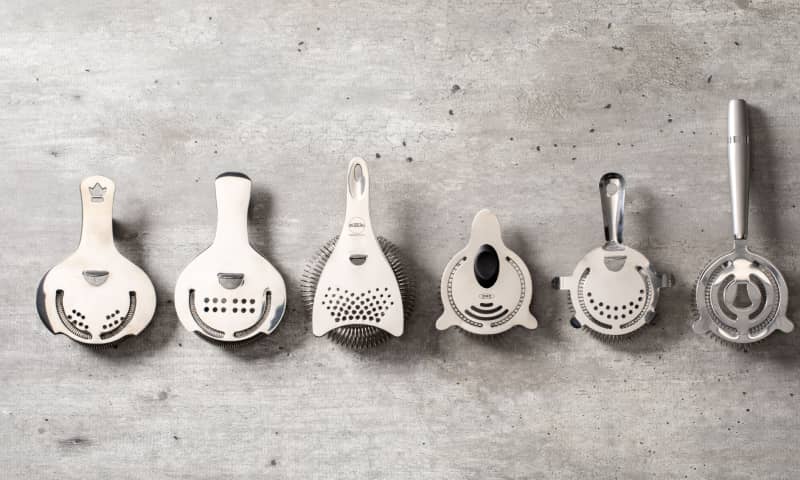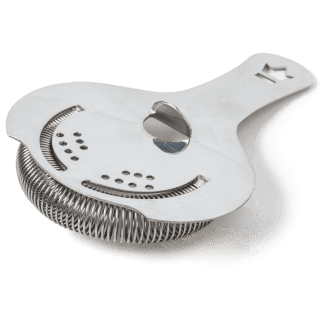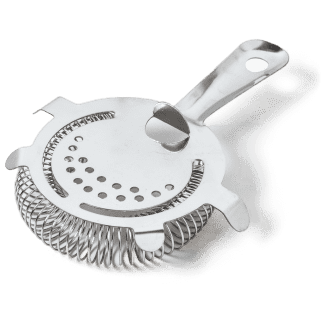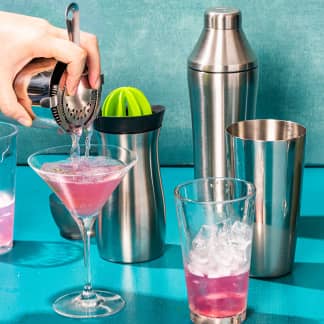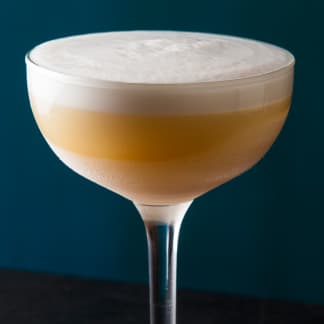If you use a Boston shaker to make cocktails, you’ll need a separate cocktail strainer to hold back the ice, stray herbs, and citrus wedges as you pour your drink into a glass. There are a few types of cocktail strainers, but the Hawthorne strainer is the most commonly used. It’s essentially a slotted and/or perforated disk with a spring mounted on part of the perimeter; the spring acts as a filter as liquid exits the shaker. We wanted to know which Hawthorne strainer was best for home bartenders, so we bought six models, priced from about $4 to about $16, and used them to strain ice and other typical cocktail ingredients.
Head Design Is Critical To Fit
All of the strainers will keep large ice cubes from plopping into your drink as you pour it into the glass—the bare minimum required of any cocktail strainer. But a few factors made certain models easier to use and capable of straining more finely than others.

Cocktail shakers vary in size, so the design of the head was critical in determining how well the strainers fit on different vessels. When using a strainer, the spring goes inside the shaker and metal wings or prongs attached to the head usually keep the whole thing perched on top. Not surprisingly, we preferred models that had wings or prongs that were long enough to reach the edges of larger shakers with room to spare, ensuring that they sat securely. One of the models had prongs that didn’t quite extend to the edges of the larger half of our favorite Boston shaker, requiring us to fuss with it to get it to latch on; as a result, the whole strainer sometimes fell into the shaker.
Handles And Finger Grips Matter, Too
Two other features determined how easy the strainers were to use. We preferred models that were well balanced, with relatively short, lightweight handles, 3.5 inches or shorter. One strainer had an unusually heavy, 5-inch-long handle that upset the balance of the whole unit, making it impossible to leave the strainer on top of the shaker without holding it in place, as it would flip backwards and fall off.

We also preferred models that had finger rests—little tabs sticking out from the middle of their heads—as these allowed for a more secure grip and better control over the strainer. You simply lay your index finger on the tab and press against the head to keep the strainer held tightly against the mouth of the shaker. By pressing down on the tab, you can also compress the spring and narrow the opening through which your drink strains, allowing you to filter the drink more finely as well.
Spring Design Determines Performance
Ultimately, how finely each strainer filtered out citrus pulp, bits of muddled mint, or ice chips was the most important factor. No strainer was able to prevent all debris from passing through its spring; if you want a drink that’s completely free of ice and pulp and herbs, you’ll need to filter your drinks through both a Hawthorne strainer and a fine-mesh tea strainer, as many bartenders do. That said, most of the strainers in our lineup did a fair job of holding back unwanted material. Realistically, we didn’t mind a few stray ice chips or tiny particles of mint, though we did prefer the models that strained more finely to those that let a bit more through.

What made certain models strain better than others? First and most important, the closeness of the coils on the spring. Strainers with gaps of less than a millimeter between their coils filtered drinks very finely, allowing almost no ice, mint, or lime bits through. By contrast, strainers with gaps of 1.3 to 2 millimeters left shards of ice covering nearly a third of the surface of the martinis they strained and permitted slightly larger shreds of lime pulp and mint to pass through. Because they catch more debris than loosely coiled springs, closely coiled springs can be more challenging to clean, but we think the performance advantages outweigh any minor annoyances in cleanup.

The tension of the spring also played a role in determining how easy it was to use the strainers. We found this action much more pleasant to perform with springs that had a moderate level of tension, as they were easier to push down than springs that were stiff and tightly coiled, but not as bouncy and hard to control as springs that were loose.
The Best Hawthorne Strainer: The Cocktail Kingdom Koriko Hawthorne Strainer
Our favorite strainer is Cocktail Kingdom’s Koriko Hawthorne Strainer. With a closely coiled spring pitched at a moderate tension, it did the best job of straining. Because it had a very large set of wings, it fit securely on vessels of different sizes; a finger tab made it easy to keep our grip on the strainer and adjust how finely we poured. Finally, it had a relatively small handle that helped keep the whole unit well-balanced.
- Wide wings or prongs that reach the edges of both large and small shakers
- Short handle
- Finger tab for better grip and easier adjustment of pouring opening
- Closely spaced coils with moderate tension
- Muddle lime quarters, add water, and strain
- Muddle mint leaves, add water, and strain
- Make martinis and strain
- Have users of different hand sizes, dominant hands, and levels of bartending experience evaluate each model
- Wash 10 times in dishwasher
